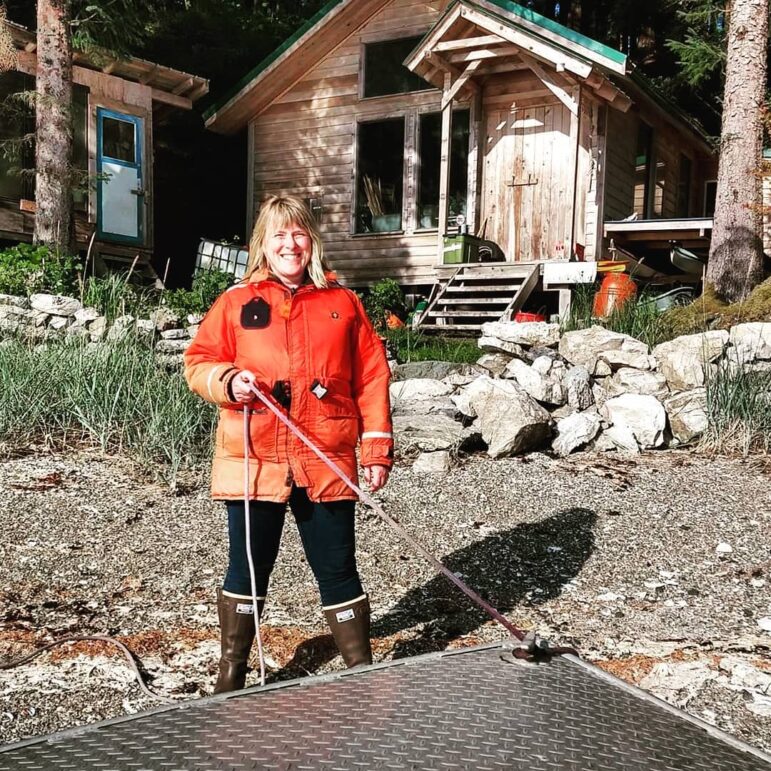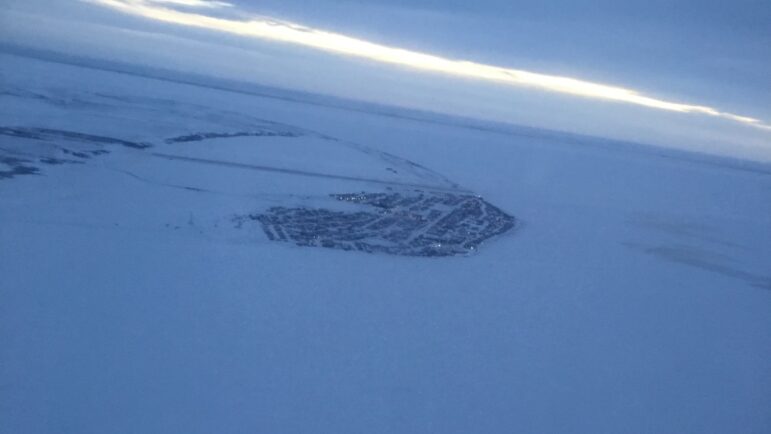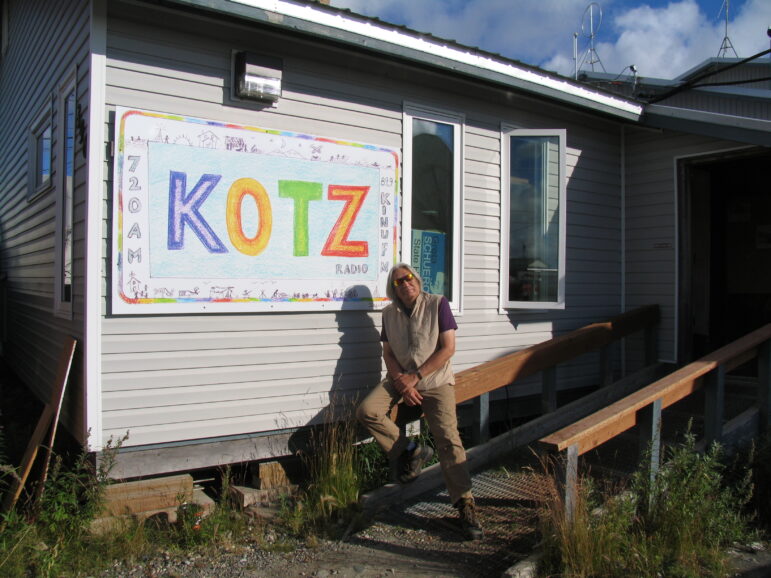Engineers, GMs go the distance to keep Alaska’s remote stations on the air

Rich Parker
KUCB's transmitter site in Dutch Harbor, located on Amaknak Island in Unalaska.
Public radio holds a unique place in rural Alaska. Outside the handful of cities in the state, public stations are often the only local voices on the airwaves, mixing Morning Edition with all flavors of music, emergency announcements, swap-and-shop shows and personal announcements for family members in remote roadless villages.
“We’re not just a source of human connection; we’re a public safety channel,” said Becky Meiers, GM of KCAW in Sitka, known to its local audience as “Raven Radio.”
If that service is a lifeline to rural Alaskans, the station managers and engineers who keep it running are the unsung heroes who must overcome weather, transportation and logistical challenges to make sure that lifeline is always on the air.
At KCAW, on Alaska’s southeast coast, Meiers is one of just seven full-time staffers who work alongside more than 150 volunteers. It’s a challenge in normal times, one that has been made even more complicated by the COVID-19 pandemic. In recent months, KCAW has cautiously reopened its studios to local volunteer hosts, using grant money to improve air filtration and provide personal protective equipment. Raven Radio has also brought more remote production technology to its volunteers, providing mics and recorders to local radio clubs to produce programs that air on KCAW and are distributed digitally.
As part of CoastAlaska, a service organization for public radio stations along the Alaskan coast, Meiers and KCAW get centralized assistance with back office administration, membership, fundraising, lobbying and engineering. When a transmitter fails, though, an engineer can be days away by plane, which means local managers like Meiers get called upon to help with troubleshooting and even repairs, especially in remote villages where public radio translators often provide the only signal on the radio dial.
In the Tlingit tribal village of Yakutat (population 662), KCAW’s translator antenna was knocked off the tower during the pandemic by what Meiers thinks was a pair of fighting eagles. The town was under a strict COVID quarantine, but radio service was so important to listeners there that local officials worked out an exemption that allowed Meiers to fly in, remain isolated from residents, and work with a lineman from the local power company to replace the damaged antenna.

Meiers, who came to Alaska in 2018 after working in Florida and Oregon, had never ridden in a floatplane before arriving at KCAW. She’s learned to negotiate with the charter pilots who are sometimes the only links to the most remote translator sites, such as Port Alexander (“maybe 20 people in the winter,” she said). On a trip there a local resident offered her a cabin to stay in, leaving food at the door so she could repair a power problem at the hilltop transmitter site.
“I can’t imagine the stress those managers are under,” said Rich Parker, CoastAlaska’s director of engineering. “But nevertheless, they’ll always pitch in and do whatever they can do to help.”
When one of CoastAlaska’s stations suffered a transmitter failure that Parker traced to a bad fan, for instance, the GM of another of its stations came to the rescue with a part from a similar transmitter that wasn’t being used. Parker said Cindy Sweat, GM of KSTK in Wrangell, also known as Stikine River Radio, isn’t an engineer, but she was ready to help get the fan where it was needed.
“She went out there in the middle of the winter and went across the snow and pulled that off with a wrench,” he said. The fan was soon in the hands of the local air freight company, which got it to Parker so that his station in Petersburg could get back on the air.
“It sounds like a small thing, but it’s a huge deal,” Parker said. “Everybody’s just willing to do what has to be done.”
For Parker, that meant a 2014 trade from a Lower 48 engineering career that included stints at big operations like Philadelphia’s WHYY and Vermont Public Radio for a new life that often finds him on tiny planes. From his base in Juneau, it’s only an hour or so to places like Sitka and Ketchikan. Several times a year, though, he’s on a bigger trip all the way out to one of Alaska’s most remote communities, Dutch Harbor at the far end of the Aleutian Islands, where CoastAlaska provides engineering assistance to KUCB, Unalaska Public Broadcasting.
The two-hour flight to Anchorage is the easy part of that trip, Parker said. “From Anchorage, you just have to wait until Raven Air, the small airline that flies to the Aleutians, has flights.” Those flights often get filled up with crews heading to fish processing plants, and even when there’s a seat, there’s no guarantee the plane will get there.
“They have winds there that are just tremendous, so sometimes the plane will go, but then there’s fog and they have to turn around and come right back,” Parker said.
“I get on small planes, I get on helicopters, I get on boats, but the only time I’ve ever been scared for my life in this job is when I was at a conference in Anchorage. I had to cross the street in a crosswalk and a guy almost nailed me in a truck,” he said.
Travel restrictions in Alaska have fostered engineering creativity. With a hard 50-pound limit on checked baggage, Alaskan engineers have learned to assemble toolkits that have all the parts and test gear they’ll need in remote areas but can still be carried by air. For small village translators, an entire transmitter setup can now fit in a case under the weight limit.
That bit of expertise proved helpful far beyond Alaska in 2017, when a hurricane destroyed the tower of Puerto Rico’s WIPR. Engineers from WNYC in New York volunteered to help rebuild the station, but the equipment they needed came from Parker and CoastAlaska. The “Radio To Go” setup that was soon on the way from Juneau to New York to San Juan included a full transmitter and makeshift studio setup, all in six cases weighing in at exactly 300 pounds total, Parker said.
On Alaska’s Arctic west coast, Pierre Lonewolf has learned to be even more self-sufficient as chief engineer of KOTZ in Kotzebue, a post he’s held for almost 40 years.

“It’s 550 air miles northwest of Anchorage. There are no roads to here, so the only way you get in is by airplane or ship, or if you have a snow machine,” Lonewolf said. KOTZ has listeners in the Russian Far East region, just 200 miles away, but its primary service area in the Northwest Arctic Borough covers an area the size of Illinois populated by just 8,000 people. “But we have caribou, bears, musk ox, moose, fish, all the things that nature gives us when you have very little people around,” Lonewolf said.
When he’s not checking for bears around his transmitter sites, Lonewolf said he’s learned to value the increased reliability of modern equipment. After struggling to keep a tube transmitter on the air at KOTZ, the station switched to a solid-state Nautel rig in 1986 “and never looked back at the tubes.”

Lonewolf also uses low-power Nautel transmitters for a dozen FM signals that relay KOTZ into tiny villages across the region. While there’s enough internet connectivity to the villages to allow him to log in remotely to solve some problems, he still depends on locals to send him pictures and monitor for outages, saving him a trip that can cost $500 just for round-trip airfare. He’d also like to be able to guide locals through video consultation, but there’s usually not enough internet bandwidth for that.
After two years of pandemic isolation, many of Alaska’s public radio engineers and managers saw each other in person again for the first time in a very different setting, the Public Radio Engineering Conference in Las Vegas in April.
“It was a good time to get out of Alaska and go see what’s going on in the world,” Lonewolf said, a sentiment that was apparently shared by many of his colleagues around the state. Alaskans made up fully 10% of the in-person attendance of about 80 public broadcasters, which made for an especially hearty celebration when Parker received the Association of Public Radio Engineers’ Meritorious Service Award.
“He’s kind of like me,” Lonewolf said. “You have to be flexible and determined here to get things done and get things working. I thought he was a great choice for that.”
For the Alaskans in Las Vegas, PREC and the subsequent NAB show provided more than just a chance to catch up with each other. At KCAW, Meiers has spent the last four years working on a project to upgrade the station’s far-flung network of FM translators.
“I was shopping around for solutions to some outstanding gaps in our project planning,” she said.
Meiers said the conferences were an essential way to remain abreast of all the ways the industry is changing, from developments in hybrid (terrestrial and digital) radio to the push to keep radio at the forefront of the auto dashboard.
“Shifts in our industry take a little while to impact stations like KCAW, but that’s not a good excuse for staying uninformed,” she said. “The more I learn, the more I want to know!”
After a long, dark winter, there was, of course, another benefit to gathering in sunny Vegas, where more than a few of the Alaskans managed to get some free time by the hotel pool at PREC.
“I got a sunburn, and it’s been years since I’ve had one,” Lonewolf said.





